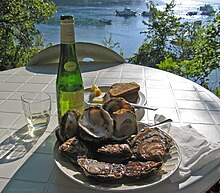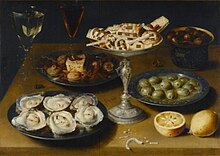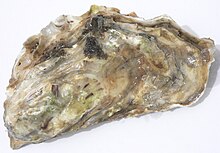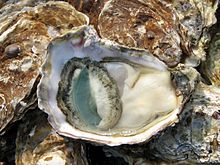Oysters (food)
Oysters (Ostreidae) is the name for several edible types of mussels . All species belong to the oyster family . In culinary terms, they are classed as seafood .
General
By far the largest amount of oysters is consumed in the Far East. They are almost always cooked there . Due to the enormous supply, oysters are relatively inexpensive compared to Europe and are eagerly consumed. In Asia and America they are usually eaten in a culinary form.
In Europe, too, there used to be large stocks of oysters, these mussels were considered to be relatively common, especially in coastal areas. Food like “ Sauerkraut with oyster ragout and Rhine wine ” was considered normal. Today oysters are much rarer in Europe. In Germany they are considered a precious delicacy and are usually sipped raw. In France, on the other hand, they are still considered a staple food and are considerably cheaper. Due to an oyster disease in 2008, which in particular decimated the French oyster banks considerably and thus impaired the harvest for years, prices have risen dramatically since 2008, but are now falling again significantly.
history
People have always, often and happily consumed oysters. They could be easily and safely collected in the intertidal zone. In Europe they were usually eaten raw, while the early Indians of America cooked oysters over fire gardens.
In ancient Greece , oysters were valued as a delicacy. Aphrodite , the goddess of love "born from the foam of the sea" was associated with the oyster. This led to the myth of the aphrodisiac properties of oysters, which still has an effect today. One of the earliest known mentions of oysters in literature comes from Matron von Pitane .
Oysters were also very popular in ancient Rome and were a must for festive occasions. The first reports of oyster gluttony reach us from this time . Emperor Vitellius is said to have devoured 1,000 oysters at one meal. Excessive oyster consumption remained a popular pleasure for the next 2,000 years. Since oysters are very low in calorific value, very large amounts can indeed be consumed, although many of the historical accounts are likely to be exaggerated.
Even Julius Caesar estimated oysters very much. In Rome the demand for them exceeded the supply, so larger quantities - cooled with snow - were imported from Gaul and Britain.
From the Middle Ages onwards, reports about culinary oysters have been mixed. On the one hand they seem to have served people in the coastal regions as cheap food, on the other hand they were considered a precious specialty in aristocratic circles. Again there are reports of gluttony. The English King Henry IV is said to have slurped 400 oysters as a starter before a multi-course meal.
In modern times, the love for oysters initially remained unbroken, consumption rose and reached its peak in the decades before the First World War , in the Belle Époque . At this time, however, increased water pollution due to population growth and industrialization. On November 10, 1902, at two different banquets in England, the participants fell ill from eating oysters, and four people died. This led to a drastic decline in the demand for oysters. In the course of the 20th century, oyster poisoning occurred again and again in England, and consumption subsequently fell to zero. It was not until 1993 that EU regulations regarding the hygiene of oysters were issued.
The problem of water pollution also appeared in France around 1900. From 1939 onwards, very strict regulations for the protection of consumers were enacted, which in principle still apply today, and compliance with which is strictly controlled. Oyster farming in heavily polluted areas - for example in Marseille and Concarneau - had to be stopped by official order. Oyster cultivation in the Mediterranean has almost come to a standstill, also due to water pollution.
The demand for gourmet oysters has remained high in France (where they can still be obtained today at a fraction of the prices charged in other regions of Europe, especially near the farming areas), but in most of the rest of Europe it has increased over the course of the 20th century Century or came to a complete standstill. Millions of Europeans have never eaten oysters. In contrast, oysters are enjoying increasing popularity in Asia. Preserved oyster meat from the Asian region is now also offered cheaply in Europe.
Oysters and Health
| Nutritional value per 100 g | |
| Proteins | 9.0 g |
| carbohydrates | 4.8 g |
| fat | 1.2 g |
| potassium | 265 mg |
| phosphorus | 161 mg |
| sodium | 110 mg |
| zinc | 42 mg |
| calcium | 22 mg |
| magnesium | 19 mg |
| iron | 3.1 mg |
| copper | 0.9 mg |
Oysters are considered health promoting. The calorific value is low at 272 kJ (65 kcal ) per 100 g ; therefore oysters are hardly filling and are often eaten as a starter. Oysters are low in fat and carbohydrates , but the vitamins A , B1 , B2 , B3 , B12 , D and E . There are also many minerals in the oyster meat .
hazards
Eating dead raw oysters can cause poisoning. Therefore, when eating, care is taken to ensure that they are still alive when opened - recognizable by the tightly closed shell before opening and the retracting edge when drizzled with lemon or touched with a knife. Oysters accumulate environmental toxins ; it is therefore mandatory to regularly check the waters around the oyster farms in this regard. Collecting wild oysters outside of controlled waters carries a risk. In addition, oysters can contain the bacterial species Vibrio vulnificus , which can cause blood poisoning in people with weak immune systems.
aphrodisiac
The oyster has been attributed an aphrodisiac effect since ancient times ; In Greek mythology , the goddess of love Aphrodite sprang from an oyster. Even Giacomo Casanova swore by the mysterious shell, sipping claims to 50 oysters a day to boost his virility. Scientifically speaking, an aphrodisiac effect cannot be proven, but slurping oysters can produce a strong placebo effect .
Purchasing
The most important thing when buying oysters is their freshness. This is not a problem in coastal areas with oyster farming. In the inland either, since an efficient and fast delicatessen wholesaling has established itself in Europe. In German-speaking countries, the oysters mostly come from France, and they are almost always the Pacific rock oyster (Crassostrea gigas).
The shell of the oyster closes very tightly, the animals can live outside the water for up to 14 days without drying out. However, they are usually sold within 10 days. The date on which the oyster was taken out of the water and put on the market is included with every oyster shipment and can be requested from reputable traders.
Trade names
The trade name of the oysters says nothing about their quality, but only about their origin. Quality features can only be derived from this subjectively.
Huîtres de parc are usually not offered outside of France. These are oysters that have not been refined in a clarifier (French: claire ), but are dispatched directly from the oyster park. In the opinion of some gourmets, they do not taste “pure” enough.

Fines de claire is the standard quality. These oysters have been in clean clarifiers for several weeks and have a pure taste. They always taste salty, always a bit like lemon and sometimes also like seaweed.
Spéciales de claire have been lying in even larger clarifiers for a longer time. They are considered particularly delicate by connoisseurs; the very "pure" taste can, however, also be perceived as boring.
Huîtres sauvages are particularly large oysters. They are mostly unsuitable for slurping and are intended for cooking.
Marennes-Oléron are oysters from this French region on the Atlantic, they are considered to be above average. They smell and taste like the sea and can often be recognized by the pronounced green color of the flesh.
Gillardeau oysters are particularly valuable and expensive. While seafood is usually marketed without naming the producer, Gérard Gillardeau has made a name for himself as an oyster farmer. In terms of quality, his oysters correspond to the “speciales de claire” and are perceived as either particularly “pure” or particularly boring.
For many enthusiasts, Bélon oysters are considered the pinnacle of enjoyment. While all the oysters described above are the Pacific rock oyster (French: huître creuse ), the "Bélon" is a European oyster (French: huître plate ). This "flat" rarity, in contrast to the other species mentioned, does not live on rocks but in the silt - named after the river Bélon of the same name in Brittany - tastes very subtle and slightly nutty. It is more expensive than most other types of oysters.
Pied de cheval are particularly large European oysters. They can usually be sipped anyway and are considered a rare and expensive specialty.
Other, rather rare names for the Pacific rock oyster are “Cancale” and “Rivière d'Etel” (France), “Oostende” (Belgium), “ Sylter Royal ” (Germany) and “Loch Fyne” (Scotland). The rare European oyster also operates under the names “Imperiales” and “Zeeland” (Netherlands), “Colchester” (England) and “Galway” (Ireland). The “Bluepoint” (Connecticut) enjoys a good reputation among American oysters.
Sizes
Similar to paper formats, the smaller the number, the larger the oyster. A "No. 2 "is therefore larger than a" No. 3 “, these two sizes are good for slurping. Smaller specimens are more suitable for slurping than large ones. Very large and very small oysters are only suitable for cooking.
Pacific rock oysters ( creuses ) France
| designation | Weight |
| No. 0 | approx. 150 g |
| number 1 | approx. 125 g |
| No. 2 | approx. 100 g |
| No. 3 | approx. 75 g |
| No. 4 | approx. 60 g |
| No. 5 | approx. 50 g |
Pacific rock oysters ( creuses ) France, alternative
| designation | Weight |
| Très Grand (TG) | > 150 g |
| Grand (G) | 75-99 g |
| Moyen (M) | 50-74 g |
| Petit (P) | <50 g |
European oysters ( plates ) France, England, Ireland
| designation | Weight |
| No. 00000 | 150 g |
| No..0000 | 120 g |
| No..000 | 110 g |
| No. 00 | 100 g |
| No. 0 | 90 g |
| number 1 | 75 g |
| No. 2 | 60 g |
| No. 3 | 50 g |
| No. 4 | 40 g |
European oysters ( Imperial ) Netherlands
| designation | Weight |
| 0000000 | 100-125 g |
| 000000 | 90-95 g |
| 00000 | 80-85 g |
| 0000 | 70-75 g |
| 000 | 60-65 g |
| 00 | 50-55 g |
storage
Oysters are still alive when you buy them and are highly perishable. They should be stored at a temperature of 5–10 degrees; the vegetable drawer or a cool cellar is usually ideal here. It is perfect to store the oysters with the curved side down and wrap them in a damp cloth. Under no circumstances should oysters be stored in water. In fresh water they die within a short time. If one of the animals died, it could infect the others. Also, oysters must not be stored in sealed plastic bags, otherwise they will suffocate.
Oysters can be frozen. This kills the animals, but they can be consumed for up to three months. After thawing, they must be processed (cooked) immediately; raw consumption is not recommended.
to open
Check: Before opening it must be checked whether the bowls are tightly closed. If this is not the case, the oyster is already dead. Eating raw dead oysters can lead to food poisoning. In restaurants, however, the quality standard in this regard is so high today that oyster poisoning almost no longer occurs. You can tell from the bad smell at the latest that the oyster is inedible.
Accessories: Opening oysters requires strength and skill. Oysters are much easier to open if you take them out of the cold about an hour before opening. They should not be cold when opened. The hand holding the oyster should be protected by a good glove, or at least by a cloth. Chain gloves made of steel mesh, which are available in specialist shops, are ideal . Every year around 2,000 French people injure themselves so badly when opening oysters that they need medical help. A special oyster knife is essential to open it; normal kitchen knives can break easily and cause injuries. Oyster knives are quite expensive in Germany, while in France they are traded for only a few (sometimes around two) euros and are often supplied with a basket of oysters.
Opening: When opening, the shell is cracked first and the upper sphincter is severed. To do this, the oyster is held or placed on a surface so that the bulbous shell is at the bottom and the hinge points towards the body. A common method is used to attack the shell on the hinge, which is located at the pointed end of the oyster (red arrow in the right figure). For this you need an oyster knife with a long pointed blade, as shown. After forcefully penetrating the hinge, the shells are spread open by turning the knife. Then the upper sphincter is severed, if possible without damaging the meat of the oyster. It is also important to ensure that no impurities from the oyster exit get into the oyster meat. Another method is to break open the oyster from the side. The knives used for this purpose have a relatively wide blade. However, the knives offered in Germany for this purpose often have such a thick blade that it can hardly be pushed between the two halves of the shell. There is therefore a risk that the oyster shell will splinter and the splinters get into the oyster.
The sphincter is above the center of the oyster, slightly to the right of the midline (red dot in the picture). After the top (flat) shell has been removed, the oyster can be served.
consumption

Serving: Raw oysters are usually served over crushed ice. On the one hand, this has optical reasons, but it also prevents the seawater present in the oyster from leaking. The ice is not required to prevent the oyster from spoiling and it affects the taste, making its use questionable. The seaweed from the oyster basket, used to protect and restrain the animals, is often used as a decoration. The upper bowls have been removed and are usually not served.
Slurping: If the oysters have been served correctly, the mollusc is still attached to the lower shell. With the oyster fork , the meat is removed from the remaining part of the sphincter. Then the oyster is brought to the mouth with the flat side (in the picture the upper side) and slurped in one go.
Bread: Oysters are hardly filling because of their low physiological calorific value of approx. 272 kJ per 100 g in small quantities. Therefore, special oyster bread (a dark mixed rye bread) and butter are usually served as a source of energy. However, this bread not only has the function of supplying energy, but also serves to provide a taste contrast to the oyster without leaving an excessively strong taste in the mouth (then subsequent oysters would no longer taste good).
Lemon: Traditionally, a piece of lemon is added to the oysters. Some consumers sprinkle it on the meat to check that the oyster is actually still alive. If this is the case, the outermost part of the shell, the beard, contracts slightly when it is drizzled. This type of “freshness check” is not very reliable and therefore not very useful. In addition, the strong lemon juice dominates the rather delicate taste of the meat.
Vinaigrette: In France it is customary to serve a vinaigrette , which is usually made of vinegar and chopped shallots. This liquid, but also the hot shallots, mask the subtle taste of the oysters and is therefore controversial.
Oyster water: There is usually a liquid in the oyster shell. This is ordinary salt water that the oyster brought back from the sea. If you prefer salty food, sip the salted water with it, otherwise it is discreetly poured into the ice. It is not about the - supposedly precious - "oyster water". The latter is no longer used these days. Oyster water is created when the oyster is separated from the lower shell and then left to stand for at least 30 minutes. As a result of the injury to the lower sphincter muscle, the oyster “bleeds” and the shell fills with a milky liquid. This “oyster water” used to be collected and drunk, but this is no longer common today.
Taste: Since different types of algae are found in different coastal regions, the taste of oysters varies depending on the place of origin. Oysters always taste salty, although this saltiness is perceived as very pleasant with good oysters. Oysters also taste like “sea” ( le goût de la mer ), so they have an aroma that is reminiscent of sea air and seaweed. Some oysters have a slightly nutty aroma, others a slight undertone of fresh cucumber or lemon. The Pacific oyster usually tastes “fresh” or “shiny”, the European oyster (for example Bélon) rather “meaty”. The consistency of the oyster is also a quality feature. The meat should be "firm", under no circumstances spongy or milky.
Live consumption : Live consumption is a consumption variant. Because if oysters are eaten raw, they should still be alive to prevent possible poisoning.
Oysters and wine
A light and completely dry white wine is the perfect companion to oysters . In France, the Muscadet de Sèvre et Maine, a very neutral wine from the western Loire region with a slight yeast note , is considered particularly suitable , and the somewhat more rustic Gros Plant from the same region is also considered suitable. The Sauvignon Blancs from the Sancerre and Pouilly-Fumé appellations are also recommended, at least their young and rather simple representatives. For non-French wines, for example, the Swiss Fendant , the Austrian Welschriesling and various light Italian white wines, such as Verdicchio dei Castelli di Jesi or Vermentino di Sardegna .
Under no circumstances are heavy, aromatic or sweet wines and all red wines suitable . Champagne or a high-quality bottle- fermented Riesling sparkling wine can also be drunk with oysters , while a simple sparkling wine or Prosecco is not considered the perfect combination with the subtle oysters due to the high carbonic acid content. In Belgium , beer is drunk with oysters , especially the high-alcohol Trappist beers . Their slightly sweet and malty taste complements the nutty-salty aroma of the oysters. The combination of pilsner and oysters is not common. In Ireland, stout is popular with oysters , which is probably close to the Belgian custom.
The "R" rule
It is often said that one should eat mussels only in months with an "R" in the name, so of Septembe r to Ap r il. Oysters should be avoided in the months of May to August. The reason is sometimes assumed that the summer heat would be harmful. This is wrong. Firstly, the heat affects not only oysters, but all seafood in the trade, and secondly, the technique of cooling with ice has been known since ancient times.
Oysters spawn in summer. During this time they are milky and the consistency of the meat also changes. The oysters look whitish, swollen and do not taste so good when they are "in the milk". Although the Pacific oysters, which are common today, excrete the spawn after a few days, unlike European oysters, this does not change the change in consistency of the oysters during this time. Obviously due to the lack of knowledge of the traders, milky oysters are mainly found in Germany at this time, but never in France. There one switches to the non-reproductive triploid oysters or to oysters from colder waters.
The "R" rule has a completely different cause. In the 18th century there was a brisk trade in oysters in France, domestic demand was high and large quantities were exported to England and Holland. As a result, the oyster beds were fished so radically that the stock was endangered. As an emergency measure, it was issued in 1759 that no oysters could be fished between May and October. This measure should protect the oyster stocks during the spawning season.
The decree was only partially successful. As a result, stricter regulations were enacted in 1766 and 1787, according to which in some French regions oysters were not allowed to be fished between April 1 and October 15. These measures gave rise to the popular "R" rule.
Nowadays, the oysters do not have to be spared during the spawning season, as the oyster cultures are usually built up with seed oysters from farms that are available in very large quantities. And since today's oysters taste no worse in summer than in winter, they can be enjoyed every month of the year. Some experts believe that oysters taste best in May (a month without an “R”) and weakest in September (a month with an “R”).
literature
- Peter Frese: Oysters / Huitres / Oysters. Culinary walks on the beach. Hädecke 1994. ISBN 978-3-7750-0255-4 .
- Mary Fr. Kennedy Fisher: Oysters, for example. Instructions on how to handle a delicacy. European Publishing House 1999. ISBN 978-3-434-50445-0 .
- Patrick McMurray and Patrick MacMurray: Oysters. Small compendium for gourmets. Neuer Umschau Buchverlag 2007. ISBN 978-3-86528-620-8 .
- Rudolf Kilias: Oysters. Ostreidae. Westarp Sciences 2000. ISBN 978-3-89432-860-3 .
- Ronald Gutberlet: Oysters, Crabs, Crabs and Lobsters. Hamburg 2001. ISBN 978-3-203-78309-3 .
- Michael Türkay et al .: mussels and oysters. Product knowledge of shellfish, kitchen practice, recipes. Gräfe & Unzer 2002. ISBN 978-3-7742-4272-2 .
- Rebecca Stott : Oyster (Animal) . Reaction Books 2004 (English) ISBN 978-1-86189-221-8 .
- Mark Kurlansky: The Big Oyster: History on the Half Shell. Random House 2007 (English) ISBN 978-0-345-47639-5 .
- Shirly Line: Oysters: A True Delicacy. Macmillan 1995 (English) ISBN 978-0-02-860376-6 .
- George C. Matthiessen: Oyster Culture. Wiley-Blackwell 2001 (English) ISBN 978-0-85238-279-0 .
- Philip M. Parker: The 2007 Import and Export Market for Oysters in France. ICON 2006 (English) ISBN 978-0-497-60447-9 .
Web links
Individual evidence
- ^ Rudolf Kilias: Oysters - Ostreide . Westarp Wissenschaften-Verlagsgesellschaft mbH, Hohenwarsleben 2000, p. 142.
- ↑ Mysterieuse oyster disease depletes oyster stocks
- ↑ Oysters and Truffles in 4th Century BCE Athens on theoystersmyworld.com ( Memento from September 23, 2013 in the Internet Archive )
- ↑ Centers for Disease Control and Prevention on Vibrio vulnificus ( Memento from September 17, 2009 in the Internet Archive ) (English)
- ↑ Katja Heise: Nutrition: When the food bounces off the plate. In: welt.de . May 22, 2013, accessed October 7, 2018 .
- ↑ milky oysters













